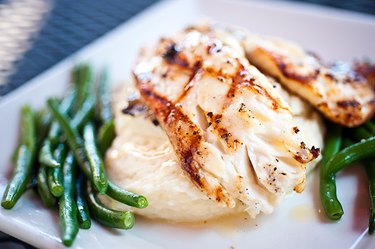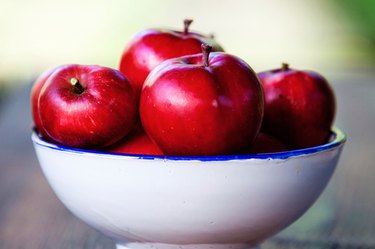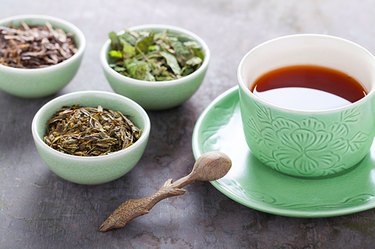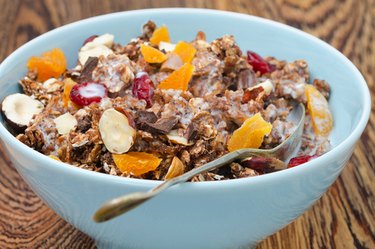
Choosing healthy-but-delicious foods that keep you satisfied, fight off that sweet tooth and rev up your metabolism can make slimming down a whole lot easier.
Here are 10 waistline-friendly choices to get you started. Are any of your favorites on this list of foods to get lean?
Video of the Day
Video of the Day
1. Avocados
Can creamy avocados help shrink your middle? Research says yes!
A review published January 2013 in Nutrition Journal found that those who regularly consume this food have significantly lower BMIs and smaller waistlines than those who do not. Avocado consumption is also associated with improved overall diet quality, as the fruit provides various vitamins, minerals and phytochemicals.
Tip
Stick to a healthy portion size. One ounce of avocado (which is a nice amount to spread on toast!) is approximately 34 calories, per the USDA.
"Avocados average about 20 grams of fat. But what makes them a great food to include in a diet is that 65 percent of that fat is monounsaturated, which is considered to be more heart-healthy because of its ability to lower LDL (bad) cholesterol," Laura Giannone, RD, CDN, a consulting nutritionist in Freehold, New Jersey, tells LIVESTRONG.com.
The creamy fruits are also a good source of potassium, folic acid, vitamin E and fiber, she adds, and have close to 5 grams of fiber, which is more than one slice of some whole-grain breads.
"What makes them diet-friendly also is that they're so versatile," Giannone says. "They can be whipped into a smoothie, smeared on a sandwich or simply dug into with a spoon."
How to Enjoy Avocados
Start your morning with an Avocado Breakfast Sandwich, packed with whole grains, lots of protein and healthy fats. Got a sweet tooth? Try Avocado Chocolate Mousse.
2. Mangoes
Mangoes are a sweet, tropical fruit and one of the best choices to satisfy a craving without the guilt while improving your overall diet. One cup of fresh mango has about 100 calories and 2.6 grams of fiber, per the USDA, and it's an excellent source of vitamins A, C and folate.
A January 2013 study published in The Journal of Nutrition and Food Sciences used national food intake data and concluded that those who ate mango had higher levels of nutrients such as potassium and fiber, and they also weighed less and had smaller waistlines compared to those who didn't eat mango.
How to Enjoy Mangoes
This Mango Berry Chia Parfait is a sweet treat that’s good for any time of the day.

3. Apples
An apple a day may keep your waistline at bay.
Apples are rich in antioxidants — specifically, polyphenols — dietary fiber, carotenoids and other nutrients, and a review published April 2018 in the Journal of the American College of Nutrition revealed that these micronutrients promote anti-obesity effects.
A medium-sized apple has about 95 calories, per the USDA, and provides the filling soluble fiber pectin, which, according to the Harvard T.H. Chan School of Public Health, may keep you fuller longer, so you won't feel the need to reach for something else (with a ton of calories).
How to Enjoy Apples
Sip on this Golden Delicious Green Juice Smoothie if you’re looking for a fiber-rich snack. Or try one of these 8 other healthy apple snacks.
4. Fish
Protein provides more satiety than carbs or fat, which is why it can be easier to lose weight on a high-protein diet, according to an August 2012 review in the British Journal of Nutrition.
Fish may be the best for keeping you full on fewer calories because it has a higher protein-to-calorie ratio than meat or poultry, according to Seafood Health Facts. Plus, seafood tends to be low in total fat as well as saturated fat, and it's easy to digest. Overall, picks like tilapia, cod and salmon should be on your list of foods to get lean.
How to Enjoy Fish
Get a whopping 31 grams of protein from this Baked Fish with Brown Rice and Veggies dish.
5. Herbs and Spices
Naturally calorie-free, herbs and spices are one of the easiest ways to help you cut calories by allowing you to enhance the flavor, aroma and color of your food without adding extra fat, sugar or sodium.
Herbs and spices are known to be among the most antioxidant-rich foods in the entire food supply, according to a September 2012 review in Antioxidants, which is another reason they can help you get lean.
"Of all the spices that exist, the one that has the most merit as an appetite-suppressant and may assist with weight loss is capsaicin, the active ingredient in chili and cayenne peppers," Giannone says. "Several studies have shown that capsaicin leads to increased satiety and, therefore, fewer calories consumed."
It does so by increasing thermogenesis, she explains, which is heat production in the body. "Some studies have shown that people who consumed capsaicin burned an average of 50 to 200 calories more than those who did not consume it," she adds.
How to Enjoy Herbs and Spices
Splurge without the guilt with this Cinnamon French Toast with Yogurt recipe.

6. Tea
Enjoying a cup or three of tea can be a boon for shedding pounds.
An October 2013 review published in the American Journal of Clinical Nutrition reported that polyphenols — bioactive compounds in tea — and caffeine have been shown to increase energy expenditure and fat oxidation.
An analysis published November 2019 in Nutrients concluded that tea drinkers have lower BMIs and overall healthier diets.
Plus, because tea has little to no calories in a cup, it's a great way to replace high-calorie, sugary drinks.
How to Enjoy Tea
Try this Blue and White Elixir, made with white tea, the antioxidant king of teas.
7. Beans
Antioxidant-rich beans have been touted as a healthy food that can aid in weight loss for quite some time. With approximately 12 to 18 grams of hunger-squashing protein and an average of 15 grams of fiber per cup, per the USDA, their slowly-digested starches may keep you fuller longer, according to The Bean Institute.
And a May 2016 review in American Journal of Clinical Nutrition concluded that because of all that satiating power, consuming legumes may be an effective weight-loss strategy that doesn't actually require calorie restriction.
How to Enjoy Beans
Looking for a healthy and filling side dish? Try this Italian White Beans and Spinach recipe.
8. Veggies and Leafy Greens
When it comes to weight loss, non-starchy vegetables and leafy greens are a no-brainer. They're low in calories and will keep you full because of their high water and fiber content, and you can eat a lot (in place of a smaller high-cal meal), according to the CDC.
"While there are no bad vegetables, those that get the most attention do so for a reason," Giannone says. "Spinach, Brussels sprouts, kale and peppers have antioxidants that can fight against heart disease, promote healthy vision and prevent hypertension. So, it's not just weight loss that would be the benefit — consumption of vegetables would allow a person to achieve a healthier body, too."
How to Enjoy Veggies and Leafy Greens
Fill up on leafy greens and tons of protein with these Grilled Chicken and Goat Cheese Salad or Strawberry, Cucumber and Chicken Mason Jar Salad recipes.
9. Quinoa
Known as "pseudo-cereal" since it's often mistaken for a cereal grain like rice, corn and wheat, this gluten-free, digestion-friendly whole-grain seed is loaded with protein and fiber, according to Comprehensive Reviews in Food Science and Food Safety, making it an essential ingredient when it comes to weight loss.
Quinoa may help prevent weight gain and improve blood lipids, which was suggested in a review published August 2015 in Plant Foods for Human Nutrition (more research is needed, though).
And according to a study published September 2016 in the British Journal of Nutrition, a high quantity of the mineral manganese is found in quinoa, which may aid in preventing abdominal obesity. Plus, it's been shown to protect against heart disease and improve metabolic health — an added bonus!
How to Enjoy Quinoa
Make this Quinoa “Taco” Bowl for something different on Mexican night!

10. Whole-Grain Breakfast Cereals
They say breakfast is the most important meal of the day. The problem is, many people — adults as well as kids — skip breakfast when they're rushing to get out the door in the morning.
Whole-grain cereal is a great way to get that first meal in since it's quick and pretty filling from all that fiber. An August 2013 review in The American Journal of Clinical Nutrition concluded that cereal fiber or mixtures of whole grains and bran consumption is associated with reduced risk of obesity as well as type 2 diabetes and cardiovascular disease.
Similarly, more recent studies show that eating fiber-rich whole grains helps people maintain healthier weights, as reported by Nutrients in May 2019.
How to Enjoy Whole-Grain Cereals
Get your protein and fiber and get out the door fast with this Almond Bran Crunch breakfast recipe.
- Nutrition Journal: "Avocado Consumption is Associated with Better Diet Quality and Nutrient Intake, and Lower Metabolic Syndrome Risk in US Adults: Results from the National Health and Nutrition Examination Survey (NHANES) 2001–2008"
- Laura Giannone, M.S., R.D., CDN
- The Journal of Nutrition and Food Sciences: "Mangoes are Associated with Better Nutrient Intake, Diet Quality, and Levels of Some Cardiovascular Risk Factors: National Health and Nutrition Examination Survey"
- Journal of American College of Nutrition: "Weight Loss Associated With Consumption of Apples: A Review"
- Harvard T.H. Chan School of Public Health: "The Nutrition Source: Apples"
- British Journal of Nutrition: "Dietary Protein - Its Role in Satiety, Energetics, Weight Loss and Health"
- Seafood Health Facts: Seafood Nutrition Overview
- Antioxidants: "Antioxidant Activity of Spices and Their Impact on Human Health: A Review"
- American Journal of Clinical Nutrition: "Catechin- and Caffeine-Rich teas for Control of Body Weight in Humans
- Nutrients: "Tea Consumption Patterns in Relation to Diet Quality among Children and Adults in the United States: Analyses of NHANES 2011–2016 Data"
- USDA: "Nutrition Comparison of Canned Kidney Beans vs Pinto Beans (Cooked) vs Soybeans Mature Seeds Cooked Boiled With Salt vs Black Beans vs Chickpeas (Garbanzo Beans) (Cooked) vs Kidney Bean"
- Comprehensive Reviews in Food Science and Food Safety: " Innovations in Health Value and Functional Food Development of Quinoa (Chenopodium quinoa Willd.)"
- Plant Foods for Human Nutrition: "Physiological Effects Associated with Quinoa Consumption and Implications for Research Involving Humans: A Review"
- British Journal of Nutrition: "Dietary Intake of Manganese and the Risk of the Metabolic Syndrome in a Chinese Population"
- Nutrients: "The Relationship Between Whole Grain Intake and Body Weight: Results of Meta-Analyses of Observational Studies and Randomized Controlled Trials"
- USDA FoodData Central: "Avocado, raw"
- USDA FoodData Central: "Mango, raw"
- USDA FoodData Central: "Apple, raw"
- USDA: "Mango, Raw"
- USDA: "Apple, Raw"
- Critical Review in Food Science and Nutrition: "Quinoa: Nutritional, Functional, and Antinutritional Aspects"